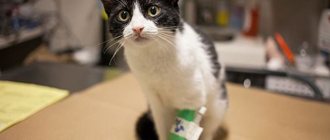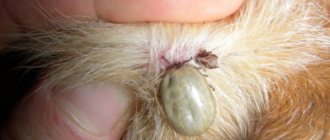A certain body temperature is necessary to maintain normal life functions of every warm-blooded creature. Elevated or decreased readings usually indicate problems with the body, which can lead to serious health problems. Representatives of the cat family are no exception - in case of deviations from the norm, the condition of the animal can only be assessed by determining temperature indicators. How do you take a cat's temperature, and what should you do if you have a fever or hypothermia?
How to take a cat's temperature?
Why do cats get fevers?
Normally, the temperature in cats is slightly higher than in people - it varies from 37.7 to 39.1 degrees, and in newborn kittens it can rise to 39.5 degrees, as in pregnant females. The reasons for changes in numbers can be pathological and non-pathological - the first are associated with all sorts of diseases: most often these are infections and inflammatory processes, but sometimes an increase in temperature is observed with malignant tumors, neurological diseases, autoimmune and hormonal disorders. Non-pathological causes include certain environmental conditions and other aspects that can affect the body's thermoregulatory system.
- Hypothermia or overheating. Prolonged exposure to open sun, too hot a room or frost causes changes in temperature indicators.
- Daily temperature changes. In the evening, the temperature of pets is several tenths of a degree higher than in the morning.
- Binge eating. Large amounts of fatty foods cause a slight increase in numbers, especially in kittens.
- Pregnancy. In pregnant cats, the temperature is 1-1.5 degrees above normal, and a few days before giving birth it decreases significantly.
- Nervous stress or physical activity. A slight increase in performance may be observed after active games or emotional experiences.
- Sterilization. After castration or sterilization of cats, they may experience changes in temperature due to stress, exposure to anesthesia, taking medications or decreased blood pressure. The indicators should return to normal within several hours, a maximum of a day - prolonged hypothermia or fever indicate postoperative complications requiring immediate medical intervention.
In other cases, a serious change in the numbers on the thermometer can be a cause for concern, especially if the increase or decrease is accompanied by a deterioration in well-being and other alarming symptoms.
Temperatures in animals can increase when environmental conditions change
For reference! Sphynx cats and other hairless or short-haired cats always seem hotter than cats with thick hair, but this does not mean they have a fever. The fact is that the presence of wool compensates for the difference between the temperature of the environment and the body, and in its absence the skin simply seems to be on fire. To assess the condition of hairless cats with any alarming symptoms, you need to use a thermometer.
Sphynx cats always seem hotter
Symptomatic diet and procedures
If the temperature is high, then you can help your pet in the same way as a child. That is, apply cool, damp cloths to the main arteries (armpits, neck, inner thighs). Such procedures help well with banal overheating.
When the temperature rises, the animal should be given a lot to drink. Sometimes it is recommended to apply pieces of ice, but you need to be careful with this procedure.
If the temperature rises quickly and has reached high numbers, you should not apply ice. This may lead to seizures. In this case, the animal is prescribed special veterinary medications to reduce the temperature. In this case, the animal requires specific treatment.
In addition, it is worth remembering that a cat’s body becomes hypothermic just as quickly as it overheats. Therefore, you should not bathe your animal in a cold shower. You can't even pour cold water on it.
You can place your cat under a fan or air conditioner when his temperature is elevated. But again it is necessary to ensure that the pet does not become hypothermic.
An effective way is to use a weak vinegar solution. They lubricate the cat's pads about once an hour.
Echinacea tincture has also proven itself well. It is necessary to mix the tincture with water (at the rate of 1 drop per 1 kilogram of the cat’s weight) and give the pet this mixture.
A high body temperature in a cat is an unpleasant phenomenon, but there is no need to panic. It is necessary to observe the animal and try to reduce the temperature using folk methods. If the animal gets worse, it must be shown to a veterinarian.
How to detect a fever in a cat
You can suspect an increase or decrease in temperature based on a number of signs, which include:
- ears, nose and skin that are hot or too cold to the touch;
- chills, severe body tremors;
- refusal to eat, nausea, vomiting;
- changes in behavior, aggression or desire to hide in a dark corner;
- increased heart rate, increased breathing;
- strong thirst;
- dilated pupils;
Dilated pupils in a cat are one of the signs of a change in temperature in an animal
- lack of physical activity, lethargy and drowsiness;
- discharge from the nose, ears and eyes.
Many owners believe that the main sign of a febrile condition is a dry, hot nose, but veterinarians refute this opinion. A warm and dry surface of the nose occurs after sleep or active play, as well as in older individuals, who are characterized by a slowdown in metabolic processes.
A dry, hot cat's nose is not a cause for concern.
A sick cat will hide from people, hide in dark corners, lie motionless and refuse food - this is the way nature tells it to fight the disease. In addition, the pet may often close its eyes, which makes its third eyelid visible, which is normally invisible from the outside.
Lethargy and loss of appetite are a symptom of an increase or decrease in temperature
Important! A severe drop in temperature in cats is more dangerous than a fever - such conditions require immediate medical attention, so your pet should be taken to a veterinarian as soon as possible.
Causes of increased body temperature
The appearance of such an unpleasant symptom in a cat as a high temperature can be associated with a variety of factors. Some of them are quite harmless, and some should force you to resort to prompt actions that will correct the pet’s condition and improve its well-being.
So, a cat may develop a fever in the following cases:
- Stress and emotional overstrain - cats by their nature are extremely emotional and impressionable animals. A long separation from the owner, the arrival of a new pet in the house, as well as moving - all these moments have a particularly negative impact not only on the psychological, but also on the physical condition of the cat. The temperature does not rise significantly. The pet may experience food refusal, a depressed and lethargic state. Typically, such a disorder goes away on its own once the cause of the stress has been eliminated.
- Overheating is a problem faced by animals that often go out on their own. Prolonged lack of fluid, as well as exposure to direct sunlight, causes the body to begin to suffer from dehydration. Also, severe overheating can occur if you leave your pet in a hot car for a long time.
- Infectious disease - any illness of an infectious nature manifests itself with an increase in body temperature. Additionally, negative signs such as vomiting, lethargy, muscle weakness, loss of appetite, and indigestion appear.
- A viral disease significantly affects the condition of the cat. Any virus quickly affects the animal’s body. Additionally, a cough appears and mucus is released from the nose.
- Poisoning - intoxication of a pet’s body with low-quality food or household chemicals is manifested not only by fever, but also by severe vomiting, as well as a complete apathetic state. The animal also breathes heavily and constantly lies down.
Attention: sometimes temperature can indicate the presence of cancer. In this case, only a veterinarian can confirm or refute the diagnosis by conducting a complete diagnostic examination of the pet.
Is it possible to find out the temperature without a thermometer?
Determining a cat's temperature without a thermometer is quite difficult - signs that may indicate an increase in temperature (hot nose, prominent third eyelid, decreased appetite and physical activity) are indirect and do not provide an accurate picture of the disease. Based on these signs, one can only suspect a deterioration in the pet’s condition, and the indicators can only be found out with the help of a thermometer.
To find out your cat's temperature, you can take a regular or electronic thermometer.
Measuring body temperature in the ear canal
Since the rectal method is very inconvenient and unpleasant for the animal, more and more owners are wondering if there is an alternative. In fact, this can be done in other ways as well. Below we will discuss how to measure the temperature of a cat using an ear thermometer.
Measuring temperature with an ear thermometer is a less painful way for cats
Practice shows that pets react quite calmly to inserting a thermometer into the ear canal, and there is no need for fixation. The procedure will be especially easy for those cats that are accustomed to their owners scratching or rubbing the inside of their ears. However, it is best to take the help of another person here too. In this case, it is best to hold the cat by the scruff (the area of skin between the neck and shoulder blades). This will allow the animal to keep its head still and not interfere with the temperature measurement. It is also interesting that this position has a calming effect on many animals.
Ear thermometers are much more convenient than rectal thermometers, which is why there is no need to be afraid to insert them deep enough. The thermometer itself should be in a horizontal position. The temperature is measured in the area of the eardrum, which is sensitive to the blood circulating in the brain area. You need to keep the thermometer in the ear until the beep sounds. The obtained result is compared with the norm.
Note! When measuring temperature in this way, you must always remember that an ear thermometer has a wider range of permissible temperature values (from 38 °C to 39.5 °C). However, as in other cases, a temperature drop below 37 °C and above 40 °C is a reason to immediately consult a doctor.
Despite the fact that at first glance this method may seem more convenient and painless, it is also not without its drawbacks. It is much more difficult to insert such a thermometer into the auricle, which is why the temperature determined in this way cannot be considered completely reliable. Another disadvantage of the device is its high cost.
How to measure a cat's temperature: accurate methods and instruments
The most informative way is to measure indicators using conventional mercury or electronic thermometers, which can be purchased at any pharmacy. Sometimes special veterinary thermometers, infrared or ear thermometers, are used for these purposes. Each of the devices has its own disadvantages and advantages, which should be remembered before carrying out the procedure.
Table 1. Advantages and disadvantages of different types of thermometers.
| Device type | Advantages | Flaws |
| Mercury | High measurement accuracy, low cost | The safety of the procedure leaves much to be desired - there is a possibility of breaking the device and causing injury to the animal; you need to hold the thermometer for a long time, which will cause serious discomfort to the cat |
| Electronic regular with flexible tip | The procedure does not take much time and is absolutely safe for the pet. | Measurement results are not always accurate |
| Universal digital | Allows you to measure temperature in different ways, quickly provides results, and is safe to use | The accuracy of the indicators is lower than that of a mercury thermometer |
| Veterinary digital earpiece | The procedure does not take much time and is absolutely safe for the pet. | |
| Veterinary digital infrared | Convenient and easy to use, does not cause discomfort to the animal | Low accuracy of indicators, high cost |
For reference! Veterinarians consider ear and infrared devices to be the least accurate, while simple mercury thermometers are the most accurate.
Normal body temperature in pets
Indicators of normal body temperature in cats and kittens
For representatives of the cat breed, a body temperature in the range of 38–39 degrees Celsius is considered normal. During the day, this indicator may change: increase or decrease by several divisions of the thermometer. This depends on a number of factors:
- A sleeping or recently awakened pet will have a slightly lower temperature because the amount of energy it expends during sleep is small. When a cat actively plays or runs, it requires more energy and its temperature becomes slightly higher.
- The time of day also has an effect. Thus, the morning thermometer readings are somewhat lower than the evening ones, since it is in the evening hours that animals like to play.
- Small kittens have a higher temperature than older cats and cats. This is explained by the extraordinary mobility of the former, an active desire to comprehend the world around them.
It has been noticed that body temperature depends on the size of the animal: the smaller the cat, the higher the thermometer readings.
How to measure a cat's temperature: step-by-step instructions
There are several ways to measure a cat's temperature - the algorithm of actions and the complexity of the procedure depend on the device the owner uses, as well as the nature of the pet.
Rectal temperature measurement
The best way to measure a cat's temperature is rectally, that is, by inserting a thermometer into the anus. To obtain accurate indicators, the procedure should be carried out when the pet is in a calm state, preferably during sleep. The algorithm of actions is as follows.
- Wrap the cat in a towel or blanket so that the head and back are visible from the outside - it is important to fix the paws, otherwise the animal will actively resist. If the cat is aggressive or restless, it is better to involve an assistant in the procedure, and also constantly talk to the pet in a calm, gentle voice, calling him by name.
- Disinfect the tip of the thermometer, lubricate it with vegetable oil or baby cream, and reset the readings to zero.
- Raise the tail, insert the tip of the device into the anus with screwing movements to a depth of no more than 0.5 cm and slightly tilt it so that it touches the walls of the rectum.
- When measuring temperature using a mercury thermometer, note the time (3-5 minutes), and when using an electronic thermometer, wait for the sound signal.
The rectal method of measurement is considered the most accurate
After the procedure, you should once again disinfect the thermometer and treat the cat with its favorite treat to compensate for the effects of stress.
Temperature measurement in the ear canal
In the ear canal, the temperature is measured only with the help of a special thermometer, which has a narrowed tip and is inserted into the ear canal.
- Measurements should be taken while the pet is sitting, holding it so that the claws rest against a hard surface and the head is motionless.
- Disinfect the tip of the thermometer and insert it deep into the cat's ear, continuing to hold its head.
- Wait for the sound signal and evaluate the indicators.
An ear thermometer is a safe and convenient, but inaccurate way to measure temperature.
The procedure takes about two minutes and causes less discomfort to the animal, but the error can be up to 0.5 degrees.
Measuring temperature while sleeping
If it is not possible to measure the temperature rectally or in the ear canal, you can use the simplest method - wait until the pet falls asleep, raise the front paw, put the thermometer under the arm and fix it well. This method can only be used in extreme cases, since it is very difficult to obtain accurate indicators. It is especially not recommended for owners of cats with long, thick hair - the hair will not allow a correct assessment of body temperature.
As a last resort, the temperature can be measured under the arm
Attention! Regardless of the method of measuring temperature, it is best to evaluate the indicators in dynamics - carry out the procedure once every 2-3 hours. If the readings gradually increase or decrease, you should take your pet to a doctor as soon as possible.
Video - How to measure a cat's temperature
Types of thermometers
There are several types of temperature measuring devices that are most often used in cats:
- mercury thermometer;
- electronic rectal;
- electronic universal.
A mercury thermometer is available, accurate, but easily damaged. If the animal is aggressive towards thermometry, the device may break during the procedure.
The electronic device is easy to use, safe, and has a small error of 0.1-0.5 degrees. To find out the data, it will take from 10 to 60 seconds (depending on the model).
It is preferable to measure temperature with an electronic thermometer, as it measures faster and therefore causes less discomfort to the animal. It is taken out at a signal. Regular mercury is measured for 5 minutes. Not every pet can sit still for that amount of time.
There are more expensive options - infrared, to measure in the ear. Collects heat impulses from the ear canal. The disadvantages of the device include its high price. Also, if you have ear disease (otitis media, ear mites), the readings may be inaccurate.
An option such as a pyrometer, which non-contactly measures the temperature in the forehead area, is not suitable for animals with fur.
How to help a cat with a fever
Eliminating fever at home is strictly not recommended - some pathologies that cause fever require immediate medical and sometimes surgical intervention. Before the cat is examined by a veterinarian, you can give her half an Analgin tablet, give her a little water, chamomile decoction or special saline solutions to prevent dehydration, and put wet towels on the neck and hips. It is impossible to give an animal any medications intended to reduce fever in humans, as they can cause serious harm to the pet’s health.
You can use a cold compress to reduce your cat's fever.
First aid for fever
If you are convinced that the temperature is elevated, giving your cat human antipyretic drugs is strictly prohibited! Before giving any medicine, consult your veterinarian at least by telephone.
Try to alleviate her condition with the following measures:
- provide a flow of fresh air - turn on the air conditioner in summer, open the window in winter;
- Apply a damp towel or ice wrapped in a thick cloth to the cat’s groin as a compress;
- provide unlimited access to fresh water - place it next to the bed.
Doesn't your temperature go down? So the reason is a health problem. If you are temporarily unable to consult a doctor, help your pet on your own:
- Take a damp cloth and wipe the paw pads frequently. Do not wet the wool!
- in case of diarrhea and vomiting, help the animal avoid dehydration - give Regidron solution. Give water and broth more often instead of solid food.
What to do when the temperature drops
Hypothermia, or low temperature, is considered a more dangerous condition than fever, so the cat should be taken to the clinic immediately or a veterinarian called to your home. A temperature of 36 degrees and below is considered a direct threat to the life of a pet - at such indicators it can fall into shock or coma. While waiting for medical help, you need to warm the animal - wrap it in a warm blanket, put it on a heating pad, and give it warm water or milk.
Cat in a veterinary hospital
If it was not possible to measure your pet’s temperature or the thermometer shows normal numbers, but the animal’s condition is cause for concern, it is recommended to show it to a veterinarian. When it comes to your pet's health, it is better to be vigilant than to ignore symptoms and leave a serious pathology untreated.
Signs of low temperature
Hypothermia (37.4 °C and below) may indicate a general weakening of the body, the presence of an infectious or viral infection, or a worsening of the underlying disease. After hypothermia or undergoing surgery using anesthesia, the development of hypothermia is also possible. So, how can you tell if your cat has a low temperature? The most common signs include:
- shiver. The main physiological mechanism that is primarily triggered by hypothermia is involuntary muscle contraction (severe and uncontrollable trembling);
- shelter in a warm place. If your cat is looking for a warm place in the house and his body is shaking a little, he most likely has hypothermia.
How to get rid of cat hair in an apartment: examples at home
In order for your pet's thermal state to normalize, you need to wrap it in a warm blanket, then place it near a radiator or use a heating pad.
Important! If the decrease in temperature did not occur as a result of the surgery, and also if the pet does not warm up for a long time or loses its appetite, it is necessary to immediately consult a veterinarian.











